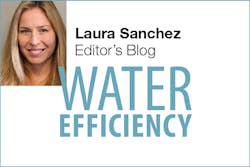Baja California’s Valle de Guadalupe is a landscape of contrasts. Vibrant green vineyard rows are bordered by arid desert. Water is scarce in this winegrowing region known for its crisp whites and complex red blends. Therefore, it has begun turning wastewater into wine.
Just north of the Valle de Guadalupe, Camillo Magoni cultivates 800 vines using reclaimed water at La Morita treatment plant in Tijuana. “It tastes like a Cabernet Sauvignon,” Magoni told Reuters of the wines. “There’s absolutely no difference. The water we’re using is very clean; it’s practically crystalline.”
Rainfall in the area has decreased while water consumption has increased due to population growth and a surge in wine production. Some feel that Magoni’s efforts to irrigate vines with treated wastewater could provide a partial solution to the region’s water shortages. “We’re going to continue and see in the future if there’s interest . . . from the industry players,” he said. If his experiment proves successful, sending treated wastewater to the Valle de Guadalupe to irrigate vineyards could support a flourishing industry.
Vidal Perez, winemaker and professor of enology at the Universidad Autónoma de Baja California, Ensenada, believes that the reused water could provide winegrowers with supplemental resources and lower prices. “As long as the water is treated to the point of causing no harm to the environment and humans, it can be very beneficial,” he explained. Perez adds that high groundwater salinity is an issue in the Valle de Guadalupe, and one that vines are particularly sensitive to.
Geophysicist Dr. Rogelio Vazquez Gonzalez explained to Roads & Kingdoms recently that the valley’s soil, once an ocean bed, contains high concentrations of residual salts. As groundwater is extracted, the salt remains, increasing the salinity of the water within the aquifers. Vazquez believes that using recycled water could offset some of that extraction.
As competition rises worldwide for an increasingly scarce resource, it appears that more areas, including Mexico’s Baja California peninsula, have discovered that wastewater can be a valuable asset. What are your thoughts about the agricultural use of recycled water?
